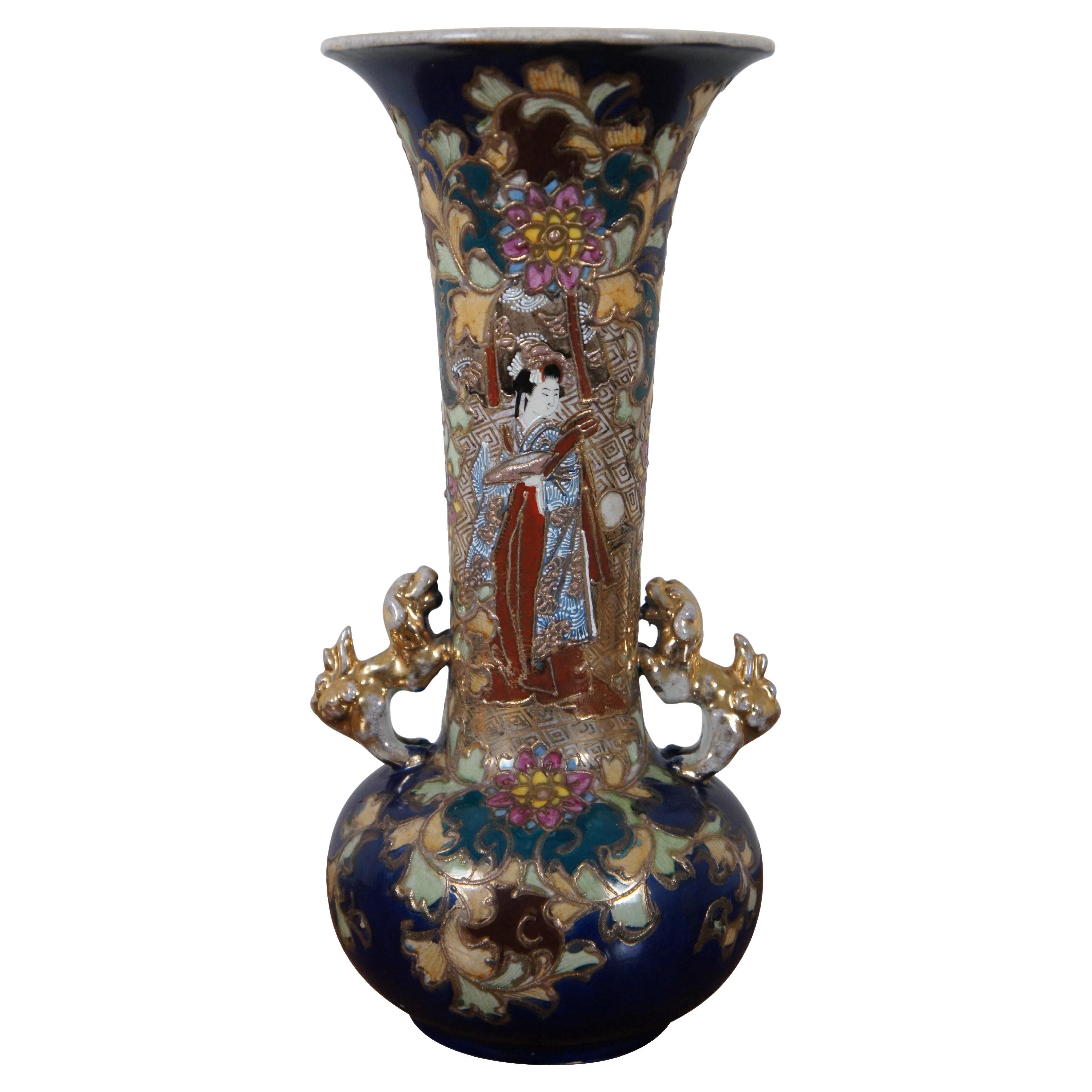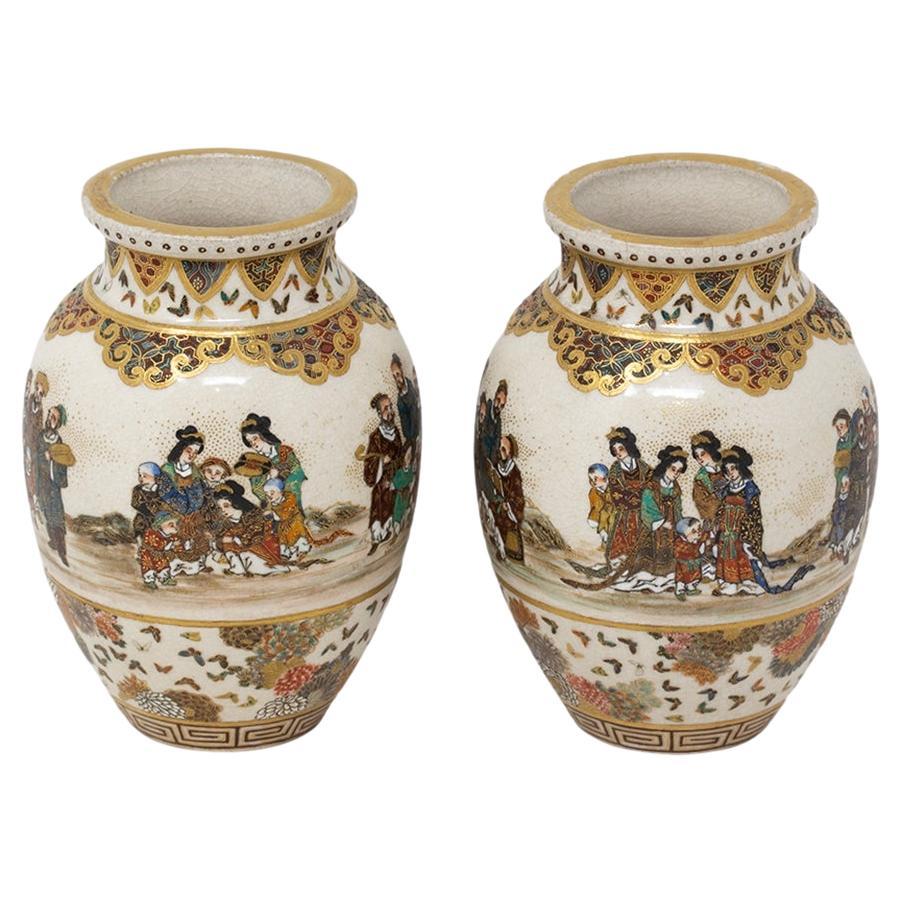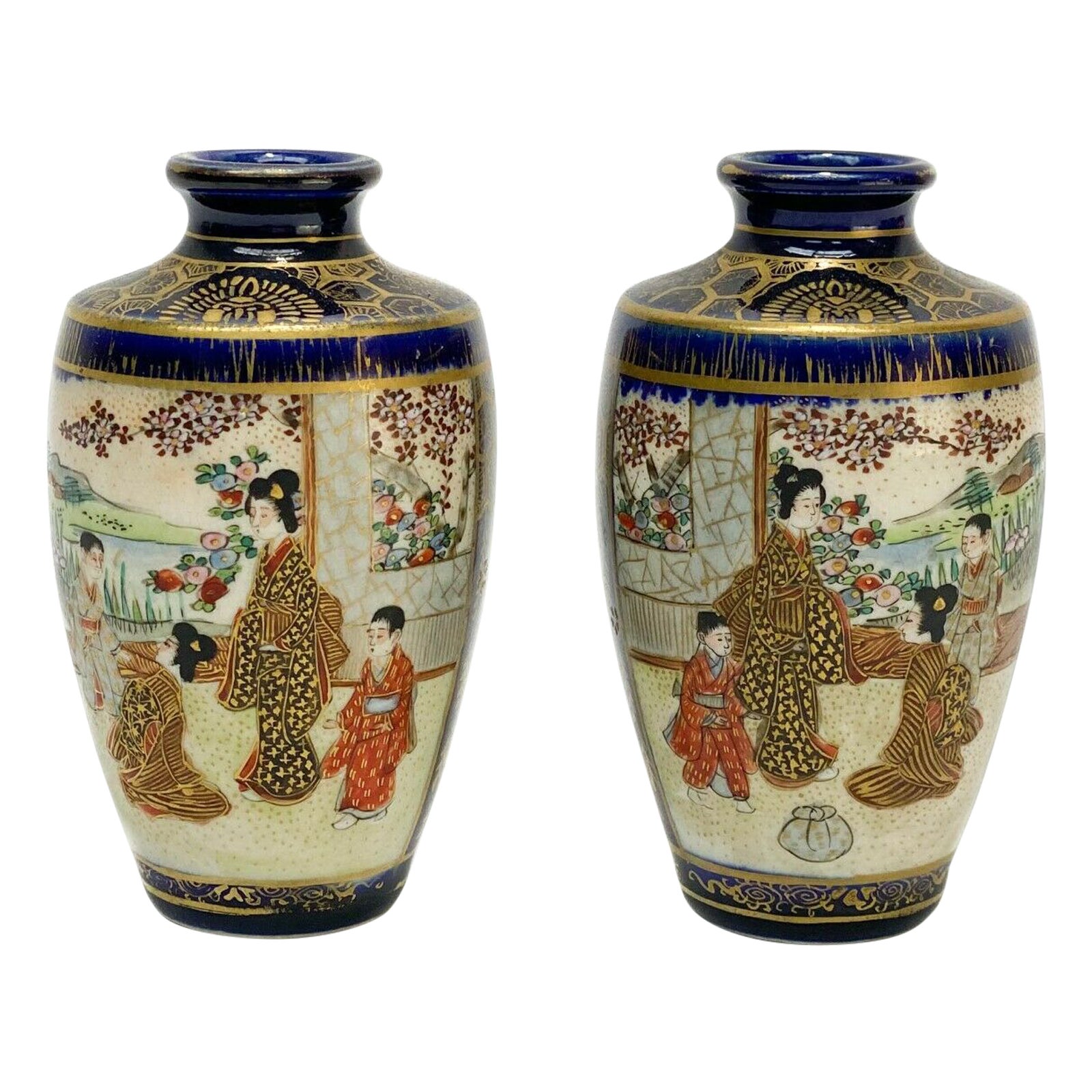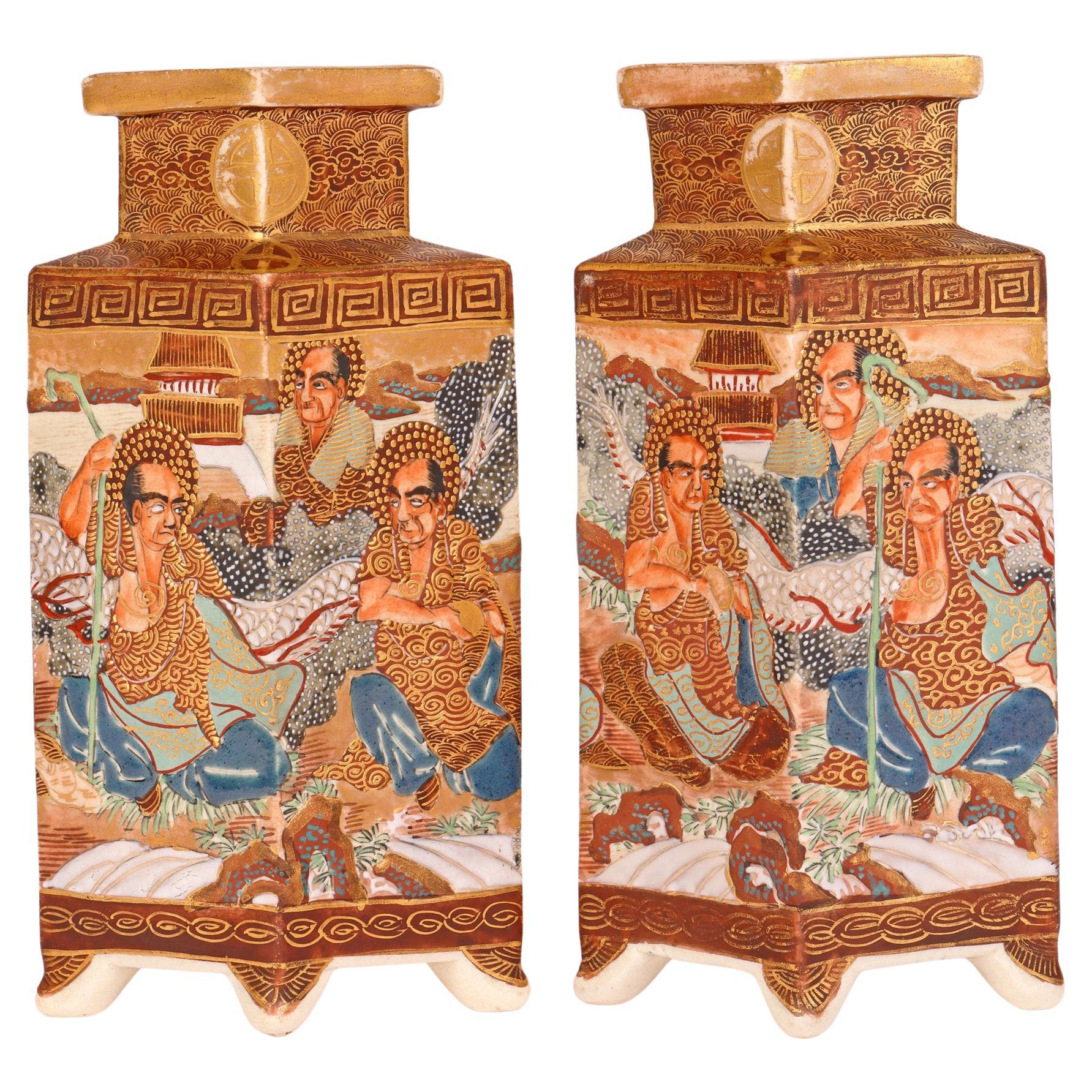Items Similar to Pair Fine Japanese Porcelain Satsuma Vases Artist Signed Meiji Era
Want more images or videos?
Request additional images or videos from the seller
1 of 7
Pair Fine Japanese Porcelain Satsuma Vases Artist Signed Meiji Era
About the Item
Antique Pair of Fine Satsuma vases with animal handles and amazing hand painted decoration. Each piece is signed by the artist. Vases are 7.5 inches tall by 4.5 inches wide.
Following the popularity of Satsuma ware at the 1867 exhibition and its mention in Audsley and Bowes' Keramic Art of Japan in 1875, the two major workshops producing these pieces, those headed by Boku Seikan and Chin Jukan, were joined by a number of others across Japan. "Satsuma" ceased to be a geographical marker and began to convey an aesthetic.By 1873, etsuke (???) workshops specializing in painting blank-glazed stoneware items from Satsuma had sprung up in Kobe and Yokohama. In places such as Kutani, Kyoto and Tokyo, workshops made their own blanks, eliminating any actual connection with Satsuma.From the early 1890s through the early 1920s there were more than twenty etsuke factories producing Satsuma ware, as well as a number of small, independent studios producing high-quality pieces.
- Dimensions:Height: 7.5 in (19.05 cm)Width: 4.5 in (11.43 cm)Depth: 4.5 in (11.43 cm)
- Sold As:Set of 2
- Materials and Techniques:
- Place of Origin:
- Period:1900-1909
- Date of Manufacture:1900s
- Condition:Wear consistent with age and use.
- Seller Location:Ann Arbor, MI
- Reference Number:1stDibs: LU6641228576372
About the Seller
5.0
Vetted Seller
These experienced sellers undergo a comprehensive evaluation by our team of in-house experts.
Established in 1990
1stDibs seller since 2022
35 sales on 1stDibs
Typical response time: 1 hour
- ShippingRetrieving quote...Ships From: Ann Arbor, MI
- Return PolicyA return for this item may be initiated within 2 days of delivery.
More From This SellerView All
- Pair Japanese Bronze Meiji Era Vases with Multiple Birds on Branches SignedLocated in Ann Arbor, MIPair Japanese Bronze Meiji Era vases with multiple birds on branches very detailed with multiple ways to display. Both vases are signed as shown.Category
Antique Early 1900s Japanese Meiji Vases
MaterialsBronze
- Large Matching Pair Satsuma Meiji Era Figural Vases Figures in Clouds Gold LeafBy SatsumaLocated in Ann Arbor, MILARGE Matching Pair Satsuma Meiji Era Figural vases figures in clouds gold leaf. Amazing multi color decoration. Vases display prominently from any decor...Category
Antique Early 1900s Japanese Meiji Pottery
MaterialsPottery
- LARGE Meiji Era Japanese Imari Full Dragon Vase with Amazing DetailLocated in Ann Arbor, MILARGE Meiji Era Japanese Imari Full Dragon Vase with Amazing DetailCategory
Antique Early 1900s Japanese Vases
MaterialsPorcelain
- Japanese Satsuma Lidded Koro Artist Signed with Dragons and Faces Very DetailedLocated in Ann Arbor, MIJapanese Satsuma Lidded Koro Artist Signed With Dragons and faces very detailed Meiji Era Vessel with amazing signature on the bottom in red.Category
Antique Early 1900s Japanese Meiji Urns
MaterialsPottery
- Large Meiji Era Cloisonne Vase with amazing bird decorationLocated in Ann Arbor, MIMeiji Period amazing Japanese Cloisonne vase. Meiji Period (1868-1912). The reign of Emperor Meiji and the beginning of Japan's modern period. It st...Category
Antique Early 1900s Vases
MaterialsEnamel
- Bright Yellow Signed Chinese Pair of Porcelain Vases with Dragon DecorationLocated in Ann Arbor, MIBright Yellow Signed Chinese Pair of Porcelain vases with dragon decoration. Signature on bottom of each vase as shown.Category
Vintage 1920s Chinese Vases
MaterialsPorcelain
You May Also Like
- Antique Japanese Meiji Era Porcelain Satsuma Figural Kutani Vase Fu Dogs GeishaLocated in Dayton, OH"Late Meiji era Kutani vase, circa 1903. A beautiful porcelain blue ground centered by an intricate Geisha flanked by gold figural Foo Dog handles. Features a floral and foliat motif throughout. Signed along the base. Kutani ware, Japanese porcelain made in Kaga province (now in Ishikawa prefecture). The name “Old Kutani” refers to porcelain decorated with heavily applied overglaze enamels and produced in the Kaga mountain village of Kutani. The powerful Maeda family had established a kiln there by 1656. The clay bodies used were gray and coarse-grained. On most pieces—dishes and bowls were especially common—a white or blue-white matte glaze was decorated in dark, restrained colours, initially greens, yellows, and some reds, and later purples and dark blues. Some items had cobalt blue decoration under a white glaze. The most noted Old Kutani pieces are “Green Kutani,” in which most of the surface is covered in a green or blue-green glaze to which one or two colours have been added (or the glaze is applied evenly over a design executed in black). The bold designs of Kutani ware drew freely from Chinese ceramics, paintings, and textiles. They are renowned for their rich pictorial ornament executed in lively, intense lines. Owing to local financial problems and difficulties in obtaining the necessary pigments, the Kutani kiln was abandoned some time in the Genroku period (1688–1704). Ceramics production in Kaga enjoyed a renaissance early in the 19th century, however, including the establishment of another kiln at Kutani in the 1820s. In addition to a revival of the styles of Old Kutani ware, there arose a style using gold on a coral-red ground, which was perfected during another spate of activity that began in the 1860s. Technical advances were made and Western-style pigments were adopted, and by the 1890s modern Kutani...Category
Antique Early 1900s Meiji Vases
MaterialsPorcelain
- Japanese Meiji Era Cloisonne Enamel Vase SignedLocated in New York, NYAn antique Japanese copper vase with cloisonne enamel design. Late Meiji period, 1868 to 1913. Miniature dark cobalt blue vase with a round body and long neck. The neck is decorated ...Category
Early 20th Century Japanese Meiji Vases
MaterialsEnamel, Copper
- Japanese Meiji Period Satsuma Vase Pair GyokuzanLocated in Newark, EnglandPainted with Continuous Scenes From our Japanese collection, we are delighted to offer this Japanese Satsuma Vase Pair by Gyokuzan. The vases of squat bulbous form with pinched neck...Category
Antique Late 19th Century Japanese Meiji Vases
MaterialsCeramic, Pottery, Earthenware
- Pair of Japanese Satsuma Hand Painted Porcelain Miniature Vases, Meiji PeriodLocated in Gardena, CAPair of Japanese Satsuma hand painted porcelain miniature vases, Meiji Period Cobalt blue ground with geometric and floral gilt decoration. Hand painted images of figures in traditional kimono...Category
20th Century Japanese Vases
MaterialsPorcelain
- Satsuma Japanese Meiji Pair Diamond Shaped Pottery VasesBy SatsumaLocated in Bishop's Stortford, HertfordshireA good and unusual pair antique Japanese Satsuma Meiji diamond shaped pottery vases decorated with monk figures with a scrolling dragon dating from the 1...Category
Antique 19th Century Japanese Meiji Ceramics
MaterialsPottery
- Japanese Satsuma Vase Yabu Meizan MeijiBy Yabu MeizanLocated in Atlanta, GAA Satsuma baluster form vase from the studio of Yabu Meizan (birth name Yabu Masashichi; 1853-1934), who is one of the most celebrated and collectible Satsuma artists from Meiji Peri...Category
Early 20th Century Japanese Meiji Ceramics
MaterialsCeramic
Recently Viewed
View AllMore Ways To Browse
Japanese Fine Porcelain
Weller Vase With Handles
Japanese Vessels Pair
Japanese Studio Vase
Small Japan Vase
Antique Vases From Japan
Hand Painted Antique Japanese Vases
Small Japanese Vases
Pair Japanese Vases Porcelain
Pair Of Japanese Porcelain Vases
Japanese Glazed Porcelain Vases
Japanese Stoneware Vase
Japanese Porcelain Art Objects
1900 Japanese Vase
Japanes Stoneware Vase
Handled Japanese Vase
Tall Pair Japanese
Japanese Vase With Handles





